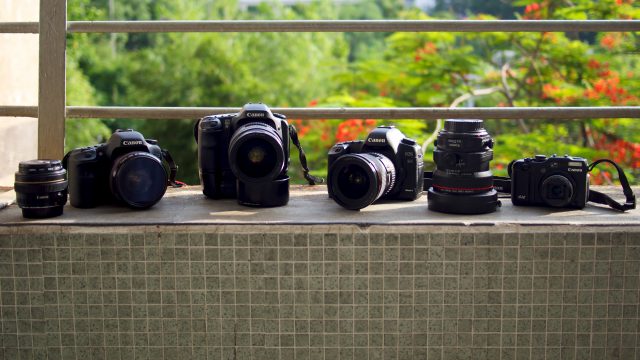Understanding DSLR camera lenses (Abbreviations & markings)
Hello Guys, here is your ultimate guide to understanding lens markings.
Does your lens has more letters after its name than a retired rocket scientist, what do all these lens markings mean?
You can refer to a lens simply by the name of the manufacturer, the focal length,& it’s maximum aperture, a Sigma 70-300 mm F/4-5.6, say, or Canon 50 mm f/1.4, but as lenses have often evolved from decades of development, they usually have a line of additional letters after their names, stamped on the barrel or printed on the boxes.
Some lens markings are about manufacturer branding, defining more range or a lens that’s built to higher standards than another, others have to do with the optics themselves and to highlight specific technologies used in the lens construction.
- AF = Autofocus, nearly all lenses have this feature
- AF-S = auto focus-silent, this feature on Nikon lenses that use a silent motor to control the autofocus.
- AL = aspherical lens, all camera lenses are made up of a number of individual lenses or elements, many of these elements are less rounded & are used in some types of lenses to help minimize chromatic aberration.
- APO = apochromatic, this features on Sigma lenses that use super-low dispersion (SLD) lens elements to reduce chromatic aberration.
- AS = aspherical (See AL)
- ASP = aspherical (See AL)
- AT-X = advance technology extra, the branding used on all current Tokina lenses.
- D = a type of Tokina lens that’s compatible with full frames SLRs.
- DA = digital auto, this feature on a range of Pentax lenses that (unlike some earlier ranges) don’t have a manual aperture ring, they have a quick shift mechanism that enables you to override focus manually, even with the lens is switched to autofocus.
- DC = this feature on Sigma lenses that are designed specifically for use with crop factor SLRs, & which can’t be used with full frame models.
- DFA = this feature in the range of Pentax lenses that will work with full frame 35 mm film cameras, but which are also optimized for using a crop-factor digital SLRs.
- DG = refers to the Sigma lens range that’s suitable for full frame SLRs (but they can also be used on crop-factor models).
- DI = Tamron’s digitally lenses have a full-size image circle, so they are suitable for full frame & crop factor SLRs.
- Di II = Tamron’s second generation digitally integrated lenses are designed to use on popular crop-factor SLRs and are not suitable for full frame models.
- DO = diffractive optics is used on a handful of Canon telephoto lenses, the technology allows these long lenses to made smaller & lighter than equivalents using conventional optical designs.
- DT = Sony lens with a smaller image circle, designed for use on the crop-sensors camera.
- DX = Tokina’s & Nikon’s way of marking lenses that are only suitable for crop factor or ASP-C – SLRs.
- ED = a lens featuring extra-low dispersion glass in one or more of its elements, to help correct chromatic aberration, this abbreviation is used by Nikon, Panasonic, Olympus & others.
- EF = elector focus, this is the name of the lens mount that Canon introduced on its first autofocus SLRs back in 1987, EF lenses can be used on all Canon SLRs.
- EF-S = electro focus-short back focus, lenses were introduced by Canon in 2003, they have a small circle so they are only suitable for use on crop-factor SLRs, a modified mount means that they can’t physically be fitted onto incompatible (ie full frame) Canon models.
- EX = Sigma’s destination for it’s premium lens range.
- F/X.X = the f-stop number is the size of the lens’s maximum aperture, measured as a fraction of the focal length of the lens, on some zoom lenses there may be two apertures quoted- F/4-5.6, for example, this means that the maximum aperture gets smaller as the lens is zoomed in, the maximum aperture on the lens may be also expressed as a ratio – so, 1:4-5.6.
- FA = Pentax lens that’s full-frame compatible, and that features an old-fashioned aperture ring.
- FO = Tokina’s focus one-touch mechanism allows you to switch quickly from autofocus to manual focus operation, and back again, by snapping the focus ring backward & forwards.
- FX = A Nikon, lens that’s compatible with its full-frame SLRs, as well as crop factor ones.
- G = gold, a designation found in top classes Sony lenses, it also used for current Panasonic Lumix compact system cameras & lenses.
- HID = high index dispersion, a type of glass used in Tamron lenses that help to minimize chromatic aberration.
- HSM = Sigma’s Hyper Sonic Motor, used in some of its lenses to provide faster & quieter autofocus operation.
- IF = internal focusing, is found in many lenses from many manufacturers, the lens is constructed so that it doesn’t change the length as the lens is focused, it also means that the front element doesn’t rotate, which can help with the use of some lens attachments, such as a petal-shaped lens hood & polarizing filters.
- II = second generation, a classic lens that’s been updated in design by the original manufacturer.
- III = the third generation
- IS = image stabilization, optical camera shake reduction found in a wide number of Canon lenses.
- L = luxury used to designate Canon’s best pro lenses, which have superior build quality & weatherproofing.
- LD = this features in Tamron lenses that use one or more dispersion lens elements to help reduce chromatic aberration,
- MM = millimeters used to measure the focal length of a lens.
- OIS = optical image stabilization, used on Panasonic lenses to reduce camera shake.
- OS = optical stabilization, used on some Sigma lenses to reduce camera shake.
- PC-E = perspective control-electronic used to designate Nikon’s range of tilt-shift lenses, which enables you to move the front elements on the lens to avoid or exaggerate lens distortion, they are commonly used in architectural photography to ensure vertical lines remains parallel in the picture.
- PZ = Power Zoom, a servo-assisted zoom facility found on some Panasonic compact system camera lenses.
- PZD = Piezo Drive, a type of ultrasonic motor used in Tamron lenses to provide fast, quiet autofocus.
- RF = Rear Focus, the group of elements nearest the camera are used to focus, providing faster autofocus, this feature found on super telephoto lenses.
- SAM = Smooth Autofocus Motor, used in recent Sony Alpha lenses.
- SD = Super Low Dispersion, the glass used in Tokina lenses to reduce chromatic aberration.
- SDM = Supersonic Drive Motor, Pentax’s fast, quiet focus motor.
- SLD = Super Low Dispersion, lens elements in Sigma lenses that reduce chromatic aberration.
- SP = Super Performance, a long-standing tag found on the top of the range Tamron lenses.
- STM = Stepping Motor, focus smoothly and quietly
- SWM = Silent Wave Motor, the high-speed quiet AF motor used on Nikon’s AF-S lenses.
- TS-E = Tilt Shift Electronic, Canon’s range of perspective control lenses (see PC-E).
- UD = Ultra Low Dispersion, a type of glass used in Canon lenses to reduce chromatic aberration.
- USD = UltraSonic Silent Drive, Tamron’s fast, quiet AF motor.
- USM = Ultra Sonic Motor, fast, low noise autofocus motor used by some Canon lenses.
- VC = Vibration Compensation, optical camera shake reduction system on some Tamron lenses.
- VR = Vibration Reduction, Nikon’s image stabilization system.
- WR = Weather Resistance found on certain Pentax lenses.
- XLD = Extra-Low Dispersion, the glass used in some Tamron lenses to reduce chromatic aberration.
- XR = Extra Reflective, type of glass used in Tamron lenses, it can bend light at bigger angles than normal glass, helping make the overall size of a lens smaller.
- ZA = Zeiss Alpha, a range of Sony lenses made by Carl Zeiss.
Thanks for reading the ultimate guide to understanding lens abbreviations, if you have any questions just post below & I will be glad to answer you :).
If you enjoy the site, don’t forget to subscribe, we will only inform you when a new article is posted.









Hey there, this is really useful stuff, I wondered what all these lens markings after the camera name mean!
And look what a long list of markings, whatever my new camera will be in the future, I will be able to decode it. Thanks for putting this all together, this must have been quite some work!
Hello Vera! glad that you liked the post :), cheers
Hi Ehab,
You have a good start on this site. You provide your readers a history that includes a detailed timeline and you link to books that can give your reader more training. I like that I can come to your site to be a pro at photography too. Your photos are beautiful and I would like to see more of them! You have a good About Me page and the use of the “quote” gave me an insite into your passion. I would like to see more consistent structure to the information you present. Keep up the good work.
Thanks for your feedback.
Wow! That’s a lot of letters. Great info though. I have a Canon DSLR that I don’t really know how to use (like a lot of people, I imagine lol) so this is really helpful. Not always the easiest thing to find a lot of pertinent information all in one place.
I’m going to bookmark this page for future reference.
Hello Caleb, thanks for your comment, it’s my honur that you will bookmark my website 🙂
There are quite some terminologies about DSLR. This is interesting.
I am interested to know if I am a Nikon user, do I need to know all the other model specifications? It is a good list though.
I am interested to know if I can use other lens for Nikon? For example, if I want to use Canon lens, is that interchangeable?
Hello Alex, sure you don’t have to know all the terminologies for all lenses, but just take idea about them, you will find AF (which means auto focus) in most of the lenses, and there are other lenses have their own abbreviations,so if you will use canon lenses you have to know the abrreviations that belongs to Canon only.
Being greeted with that image of all those Canon cameras at the top of your post is like eye candy to me. I have a Canon 6D (which I love), but only a couple of lenses at the moment. 24-105mm and 17-40mm. Although I already know what many of the terms regarding lenses means, you post definitely taught me a few more. Thanks for sharing this. As a camera buff it was an interesting read to me.
Thanks Darren for your comment.
Hi Ehab, yes, I like taking pictures but I never thought that there are so many types of different lenses. Very clear description of the lenses, no doubt and no questions. Please publish more tips for taking human portraits. The site is on the right path , keep it in that way. Cheers, Beto.
Thanks beto for your comment, i’m glad that you liked the article :),keep visiting the website & Sure i will post tips & techniques for portrait photography soon.